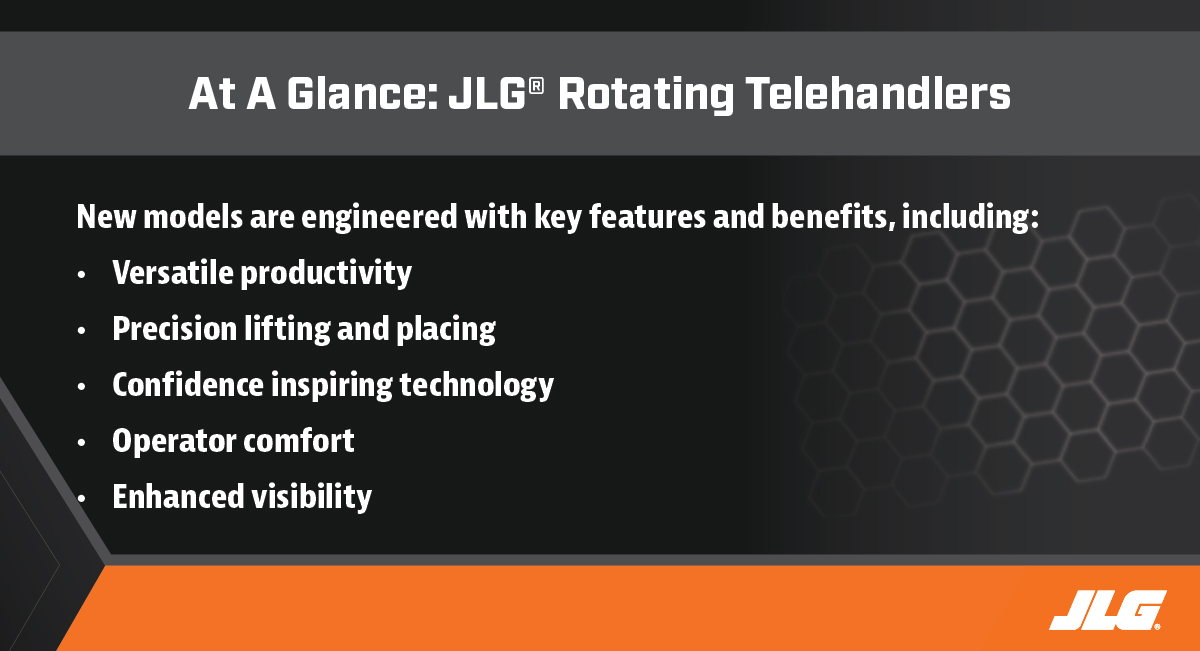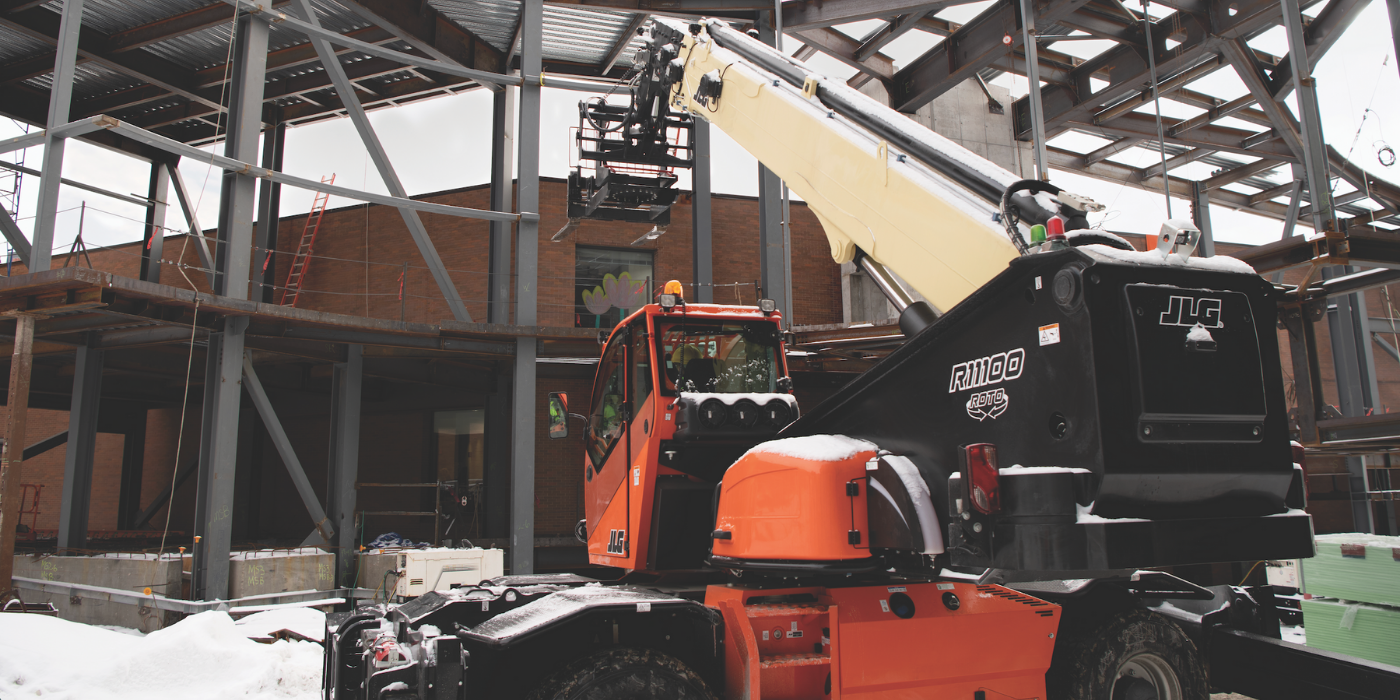 Rogerio dos Santos
Rogerio dos Santos
VP of Strategy & Portfolio Management
____
JLG Industries
The rotating telehandler market has been well-established in Europe for quite some time, and although these machines have not yet gained major traction in North America, we are seeing incremental growth each year with signals pointing towards exponential growth in the near future.
The urbanization trend has generated more and larger city centers. With those come busier streets and taller buildings with less open space between them. In these types of areas, it can be challenging to use traditional telehandlers.
An alternative in these instances is rotating telehandlers, which offer the ability to place the machine in a fixed position and reach multiple areas of a work site, which means less repositioning and a reduction in machine traffic.
In our opinion, rotating telehandlers are a machine whose time has come.

Market Introduction
To meet the growing need for rotating telehandlers in the United States, JLG has introduced three models: The R1370, R1385 and R11100. These JLG models are being produced by Italian manufacturer Dieci for sale in the United States. As the world’s largest access equipment manufacturer, JLG has a well-established telehandler footprint offering a dual brand strategy which includes both SkyTrak and JLG models, both of which are highly regarded.

By partnering with Dieci, who has a well-established rotating telehandler brand in Europe, we were able to leverage their product design and engineering expertise to bring this line of product to market quicker than we could have organically, while offering the same gold standard of product and service support that JLG customers have come to expect.
Below are some of the key features and benefits of the dedicated JLG rotating telehandler product line.
Key Features
- The three new JLG models have similar base configurations, though the R1370 and R1385 have 4-section booms. The R11100 has a 5-section boom.
- All boom sections, regardless of model, are cylinder- and chain-driven to support higher reach and greater lift capacity.
- 360-Degree continuous rotation of the upper frame enables both horizontal and vertical lift-and-place capabilities, adding a new layer of functionality where it’s difficult to maneuver a traditional telehandler.
- Front and rear scissor-style outriggers with automatic leveling jacks come standard, which enable the operator to position the machine, then level the frame up to 6 Degrees to compensate for uneven terrain.
- 3-in-1 machine capabilities allow these rotating telehandlers to complete work done not only by traditional telehandlers, but also by MEWPs when equipped with a platform attachment or rough terrain cranes up to 97-ft when equipped with a truss boom and winch in some situations.
Versatile Productivity
- The R1370 comes with a Perkins 134 hp diesel engine, while the R1385 and R11100 are equipped with 168 hp FPT diesel engines.
- All models feature a 2-speed, hydrostatic transmission to deliver a smoother ride over uneven terrain.
- Foam-filled tires come standard on all models. Air-filled tires are optional in two different treads.
- 13 specialized attachments are available, allowing them to perform a wide range of work including work platforms, crane jibs and winches, standard and rotating carriages, forks, buckets, truss booms and coupler-mounted hooks.
- Standard and continuous auxiliary hydraulics come on all JLG rotating telehandler models with optional dual-auxiliary hydraulics available to power multifunction attachments.
- A hydraulic coupler is also available to improve efficiency when switching between attachments.
Precision Lifting and Placing
- An inching feature allows the operator to run the boom at optimal speed without shifting the transmission into neutral.
- Finely tuned boom controls and soft stop slows the boom as it approaches the end of its stroke for precise lifting and placement of materials.
- A remote boom control feature allows the operator to maneuver the boom from outside the cab when obstructions prevent clear visibility of the work area.
- All models also come with an intuitive operator interface and dual joystick proportional controls.
o The right joystick operates two functions — boom lift and lower and attachment tilt.
o The left joystick controls boom extension and retraction, as well as turntable rotation.
Confidence Inspiring Technology
- Each model is engineered with three additional technologies: Automatic attachment recognition, a Load Management Information System (LMIS) and a Load Stability Indicator (LSI).
- The automatic attachment recognition system recognizes the attachment at the end of the boom, alerts the operator for confirmation, then loads the appropriate load capacity chart.
- LMIS indicates whether the load is compliant and prevents operation that violates the chart’s boundaries.
- LSI limits the rotating telehandler’s functionality when a load nears maximum capacity.
Operator Comfort
- All models come with enclosed cabs, air conditioning and a secondary heating unit for colder weather.
- Adjustable suspension seats and an adjustable steering column allow the operator to position themself comfortably.
- Integrated armrests are included to help reduce fatigue throughout the workday.
Enhanced Visibility
- A reversing camera and lighting package come as standard equipment on all models to aid job site visibility.
- Optional work lights can be added for low-light situations.
- A white noise backup alarm system can be ordered to enhance worker awareness.
o This system emits an audible alarm signal when the telehandler is traveling in reverse to alert those working in and around the machine.
It is important to know that these machines have been designed as JLG machines. They will feature our signature and trademarked cream and orange colors. At a glance, the market will recognize them as a JLG® product, and they can expect the same level of product quality, parts and service support they receive with every JLG product.

Market Advantages
So, what benefits do JLG rotating telehandlers have over other options in the market? There are three that come to mind immediately. First is that the JLG rotating telehandlers have been designed with existing telehandler’s operators in mind. The operator interface is simple and intuitive, which allows for faster training and a quicker familiarization with controls.
Another key benefit is that customers will be able to count on JLG’s US-based technical and parts support services.
Finally, JLG’s comprehensive training programs have been updated to include rotating telehandler curriculum.
An Alternative Solution
On today’s job sites, contractors are faced with tighter workspaces, more stringent safety protocols and reduced workforces. Rotating telehandlers can help improve both productivity and safety, while reducing the number of machines and machine operators required on congested urban sites.
While rotating models won’t replace traditional telehandlers or MEWPs, they certainly complement both, while offering a broad range of versatility. To learn more about JLG’s new rotating telehandlers, click here.
Do you want to stay up-do-date with industry news and issues similar to this? Make sure you subscribe below to receive monthly updates from #DirectAccess with newly posted content so you never miss important information.